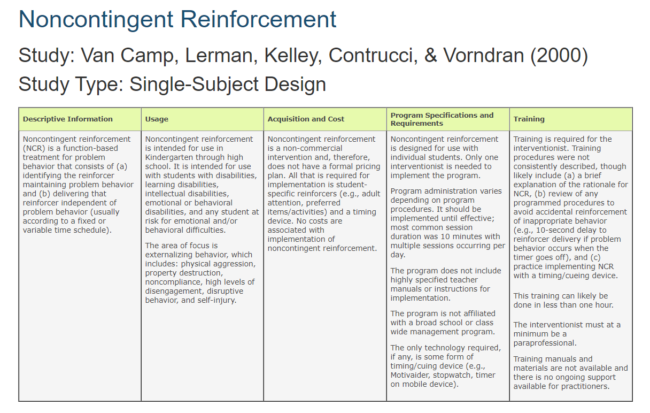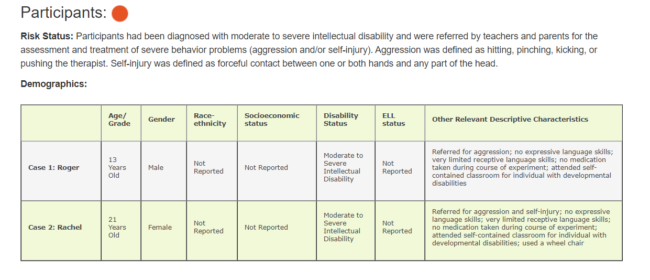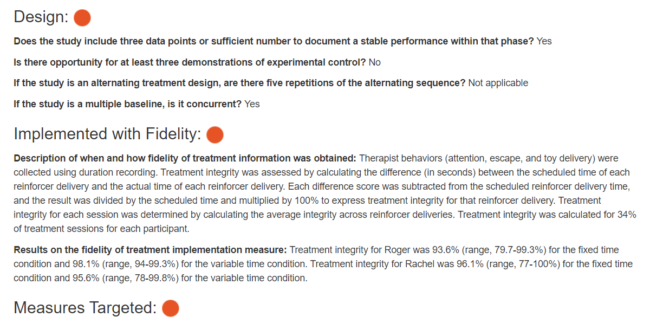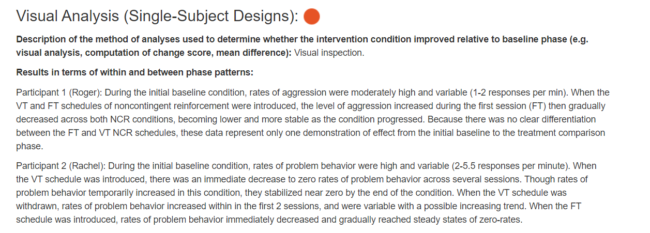Put It Into Practice

Now that we have gotten familiar with the terms, let’s take a look at how these are put into practice for selecting an evidence-based practice.
We are going to be looking at The National Institute for Intensive Intervention Tools Chart. We are going to be taking a look at a behavior support intervention called noncontingent reinforcement. Before we dive in to the tools charts, here is some information about noncontingent reinforcement.

Noncontingent reinforcement is a function-based treatment for problem behaviors. Problem behaviors consist of identifying the reinforcer that is maintaining the problem behavior and delivering a reinforcement that is independent of problem behavior. Reinforcement is delivered on either a fixed or variable time schedule. A fixed-time schedule involves the delivery of reinforcement independent of behavior after a set amount of time has passed. For example, a noncontingent reinforcement schedule of F1-30 schedule delivers reinforcement after every 30 seconds has passed independent of whether the student exhibits the target behavior. A variable-time schedule is like a fixed-time schedule but instead of reinforcement being delivered on a consistent schedule, the time can vary between delivery. For example, you may have a noncontingent reinforcement schedule of V1-30 that delivers reinforcement on average of 30 seconds, but the student may be reinforced after 10 seconds or have to wait for 45 seconds. Variable-time schedules are unpredictable in timing.

Now that we have some background information on noncontingent reinforcement, let’s dive into The National Institute for Intervention (NCII) and it’s Intervention Tool Chart.
The NCII tool chart provides information on the quality of studies that impact academic and behavioral interventions. They provide information on studies that add to the effectiveness of an intervention. They have a rubric that guides them on quality indicators for studies and how they are represented in the tools chart.
This rubric provides the quality indicators for both group and single subject research designs. The reports on each of the studies look at both the study quality and the results in terms of effects sizes for group designs and visual analysis for single-case design. Both the study quality and the results are used to make decisions about the intervention.

(Source: National Institute for Intensive Intervention)
This is the legend that the NCII provides for their Tool Chart. The graphical information tells you how they rate the study based off their quality indicators for both study design and results. This is an easy way to give a quick look at the study before getting into more of the detailed information. The bubbles, and how filled in they are, indicate the quality of the study. Here are the studies that were evaluated for noncontingent reinforcement:

(Source: National Institute for Intensive Intervention)
You can see that there are varying degress of quality for these studies. Some meet the NCII standards for quality more than others. You can see that the study done by Van Camp, Lerman-Kelley, Contrucci, & Vorndran (2000) met more of the quality indicators than the study done by Jones, Drew, & Weber (2000). However, based on this information from this tools chart, we can see that there is evidence that noncontingent reinforcement could be an impactful intervention.
Let’s take an in depth look at the information for the Van Camp, Lerman-Kelley, Contrucci, & Vorndran (2000) study.

(Source: National Institute for Intensive Intervention)
We can see that this study was a single-subject design and the information needed for usage of noncontingent reinforcement as well as materials needed, cost and training for implementation. One of the great things about NCII study descriptions is that you can find all of the information that you need all in one place.
Let’s look at some of the quality indicators and a description of the participant (remember that single-subject means there may only be one participant or the intervention is being applied to one behavior across more than one participant).

(Source: National Institute for Intensive Intervention)
This study provided detailed information on the participants and the behavior of aggression that they were looking to apply noncontingent reinforcement to. Student demographics, disability status and behavior descriptors are provided.

(Source: National Institute for Intensive Intervention)
Information about the design and implementation fidelity is provided. Remember that when an intervention is not done with fidelity, the likelihood that will positively impact student outcomes is lowered. The information provides how fidelity was collected and what the rating were during the entirety of the study.

(Source: National Institute for Intensive Intervention)
Detailed information is provided on the visual analysis of the results of the study and the intervention effects on the participants as well as the type of time schedule that was used. Notice that the whole bubble is filled in which means that this study met the NCII’s qaulity indicators for single-subject designs.

(Source: National Institute for Intensive Intervention)
Along with the detailed information for the study, NCII provides additional information on articles that test the effects of noncontingent reinforcement. Some of these articles can be found on the NCII website with the quality indicators already evaluated, and some of them have not been evaluated but can provide additional information on noncontingent reinforcement.

The quality indicators for evidence-based practices can easily be applied to experimental and single-subject designs. Evaluating the quality of studies is important in that they drive the documentation for evidence-based practices. It is important that high-quality research be the bases for determining in an intervention of practice is evidenced-based. Having research drive your practice means that the tools you are employing in your classroom are rooted in research and not in opinion or current trends in education.
To access the National Institute for Intensive Intervention tools charts, click here.
References:
Austin, J. L., & Soeda, J. M. (2008). Fixed-time teacher attention to decrease off-task behaviors of typically developing third graders. Journal of Applied Behavior Analysis, 41, 279–283.
Butler, L. R., & Luiselli, J. K. (2007). Escape-Maintained Problem Behavior in a Child with Autism: Antecedent Functional Analysis and Intervention Evaluation of Noncontingent Escape and Instructional Fading. Journal of Positive Behavior Interventions, 9, 195-202.
Falcomata, T. S., & Gainey, S. (2014). An evaluation of noncontingent reinforcement for the treatment of challenging behavior with multiple functions. Journal of Developmental and Physical Disabilities, 26, 317–324.
Ingvarsson, E. T., Kahng, S. W., & Hausman, N. L. (2008). Some effects of noncontingent positive reinforcement on multiply controlled problem behavior and compliance in a demand context. Journal of Applied Behavior Analysis, 41, 435–440.
Jones, K. M., Drew, H. A., & Weber, N. L. (2000). Noncontingent peer attention as treatment for disruptive classroom behavior. Journal of Applied Behavior Analysis, 33, 343–346.
National Institute for Intensive Intervention Tools Chart Resources. (2019). Retrieved November 4, 2019, from https://intensiveintervention.org/about-charts-resources.
Rasmussen, K., & O’Neill, R. E. (2006). The Effects of Fixed-Time Reinforcement Schedules on Problem Behavior of Children with Emotional and Behavioral Disorders in a Day-Treatment Classroom Setting. Journal of Applied Behavior Analysis, 39, 453-457.
Tomlin, M., & Reed, P. (2012). Effects of Fixed-Time Reinforcement Delivered by Teachers for Reducing Problem Behavior in Special Education Classrooms. Journal of Behavioral Education, 21, 150-162.
Van Camp, C. M., Lerman, D. C., Kelley, M. E., Contrucci, S. A., & Vorndran, C. M. (2000). Variable-Time Reinforcement Schedules in the Treatment of Socially Maintained Problem Behavior. Journal of Applied Behavior Analysis, 33, 545-557.
Wallace, M. D., Iwata, B. A., Hanley, G. P., Thompson, R. H., & Roscoe, E. M. (2012). Noncontingent reinforcement: A further examination of schedule effects during treatment. Journal of Applied Behavior Analysis, 45, 709–719.
Waller, R. D., & Higbee, T. S. (2010). The Effects of Fixed-Time Escape on Inappropriate and Appropriate Classroom Behavior. Journal of Applied Behavior Analysis, 43, 149-153.
